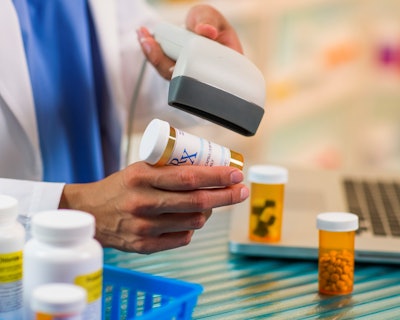
There is plenty of buzz around the potential for blockchain technology to transform and secure supply chains for increased, immutable chain of custody and tracking of products as they move through distribution channels. While the exploration of blockchain has so far been largely focused on the food industry, the pharmaceutical industry also sees tremendous value in blockchain’s ability to securely exchange serialized data from manufacturers all the way to pharmacies.
This vision has been investigated recently in a number of pilot programs conducted by leading pharmaceutical manufacturers, wholesale distributors and dispensers in collaboration with the U.S. Food and Drug Administration (FDA). FDA’s Drug Supply Chain Security Act (DSCSA) Pilot Project Program is intended to assist drug supply chain stakeholders, including the FDA, in developing an electronic, interoperable system that will identify and trace certain prescription drugs as they are distributed within the United States. It also supports an even larger vision set forth in the 2013 act, which focuses on improving supply chain visibility and transparency in the pharmaceutical supply chain. Meeting the requirements of the DSCSA and product authentication/anticounterfeit measures are the most prevalent use cases in the pharmaceutical industry using distributed ledger technology.
How blockchain helps industry meet regulatory requirements
Six of the 20 FDA-sponsored DSCSA pilots completed early this year were focused on determining the usefulness of blockchain for boosting supply chain visibility and product ownership traceability, as well as identifying a path forward for this potential game-changing technology. All six pilots incorporated GS1 Standards as an essential foundation for improved data sharing, since the standards provide a common language that can be understood by all supply-chain partners.
The DSCSA expressly requires pharmaceutical products to be serialized and labeled with specific standardized data to support an interoperable, electronic system for identifying and tracing them throughout U.S. distribution. Packages must be marked with a two-dimensional barcode containing unique product identifiers and other regulated data elements applied in a standardized way to facilitate accurate product tracking across the healthcare supply chain. This will also associate the physical product markings with the serialized electronic data exchange that will be required, per DSCSA, on or before Nov. 27, 2023.
The DSCSA blockchain pilots also centered on verifying saleable returns — meaning if a product is returned, the manufacturer and wholesale distributor work together using standards-based systems to verify the product identifiers and the transactional data before it goes back into the supply chain.
Blockchain records are permanent
This is where blockchain’s immutability comes in. In general, a distributed ledger’s value centers on its capability for validating product authenticity by enabling permanent and unalterable documentation of a product’s legitimacy and chain of custody. Counterfeit products are a problem for any industry, but in pharmaceuticals, they can lead to unthinkable consequences — literally risking lives. Confirming the absolute authenticity of a pharmaceutical product is a top priority for the industry, the FDA and healthcare in general.
Combined with the same GS1 Standards already being implemented to support DSCSA requirements, blockchain technology may unlock the key to critical, effective traceability through better data sharing — integrating the internal data and processes a company uses to track products into a larger ecosystem of external data exchange that takes place between trading partners.
Data standards fortify blockchain benefits
A GS1 data-sharing standard called Electronic Product Code Information Services (EPCIS) makes blockchain more effective, as it can help partners transmit key information on a transactional level — the what, where, when and why behind product movement through a supply chain. This standard is being used by the pharmaceutical industry in preparing for DSCSA interoperability required by 2023. The ability to accurately track pharmaceutical products as they travel throughout the supply chain assures authenticity and prevents acceptance of altered or counterfeit products, helping safeguard patients from dire consequences.GS1 US
The ability to accurately track pharmaceutical products as they travel throughout the supply chain assures authenticity and prevents acceptance of altered or counterfeit products, helping safeguard patients from dire consequences.GS1 US
EPCIS documents “what” is being distributed (the product) with the Global Trade Item Number (GTIN) encoded in the barcode as the required, unique product identifier. Dates of transaction events (when) are recorded to EPCIS using a standardized format dictated by the DSCSA as “MM-DD-YYYY,” helping eliminate errors in interpreting expiration dates. EPCIS further records “where” the product has been by leveraging Global Location Numbers (GLNs) of manufacturing facilities, distribution centers and dispensaries, so that the location history can be recorded on a blockchain with specificity. These transaction records are particularly useful during a product recall or withdrawal, as end-to-end traceability requires full knowledge of all the locations where affected or unsafe products have passed through.
Finally, EPCIS provides information on business process steps that occur, such as commissioning, packing and shipping. It documents the state of the item (e.g., saleable, expired, in transit, etc.) and may even be used to capture sensor data such as temperature, which is key for cold chain applications in certain industries, including healthcare.
Immutable data records protect patients
The ability to accurately track pharmaceutical products as they travel throughout the supply chain assures authenticity and prevents acceptance of altered or counterfeit products, helping safeguard patients from dire consequences.
One FDA DSCSA pilot led by MediLedger demonstrated that a neutral platform using blockchain technology can help the industry mitigate those risks and be used to support an interoperable system for the pharmaceutical supply chain, as mandated by DSCSA. The MediLedger Project represented a broad group of industry stakeholders, including manufacturers, national and regional wholesale distributors, pharmacies, logistics providers and GS1 US.
The MediLedger Project further reported that data privacy can be assured by implementing “zero-knowledge proof” technology, where all transactions posted to the blockchain solution are fully concealed, so that no confidential information is shared. The need for patient privacy is paramount, making such capability essential in any data-sharing protocol for pharmaceutical products.
Blockchain’s main benefits are its neutrality and the permanence of its data recording. That’s why its success depends upon trading partners’ diligent approach to data generation and stewardship. Incorrect data cannot be erased from a blockchain. Healthcare industry engagement will be needed for broad adoption of data standards, implementation and exchange. Since DSCSA mandates the establishment of these practices, these requirements will be met anyway, setting the stage for successful integration with blockchain.
Conclusion
Blockchain may well be a highly effective technology for the pharmaceutical supply chain, promising potential for faster delivery of safe medications and meeting government requirements at the same time. As with all interoperability improvements, it will depend upon the establishment of highly reliable, accurate data systems that incorporate industry standards. It all begins with data quality.



















